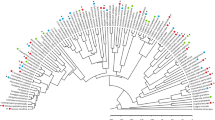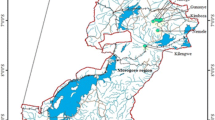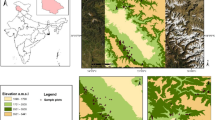Abstract
In forest ecosystems, interactions between overstory trees and understory herbs play an important role in driving plant species diversity. However, reported links between overstory tree and understory herb species diversity have been inconsistent, due to variations in forest types and environmental conditions. Here, we measured species richness (SR) and diversity (Shannon-Wiener (H') and Simpson's (D) indices) of overstory trees and understory herbs in the protected Tianshan Wild Fruit Forest (TWFF), Northwest China, to explore their relationships along the latitudinal, longitudinal, elevational, and climatic (current climate and paleoclimate) gradients in 2018. We found that SR, and H' and D diversity indices of overstory trees and understory herbs exhibited a unimodal pattern with increasing latitude and elevation (P<0.05) and negative associations with longitude (P<0.01). Along the climatic gradients, there were U-shaped patterns in SR, and H' and D diversity indices between trees and herbs (P<0.05). SR, and H' and D diversity indices for overstory tree species were positively associated with those for understory herbs (P<0.01). These findings indicate that overstory trees and understory herbs should be protected concurrently in the TWFF to increase effectiveness of species diversity conservation programs.
Similar content being viewed by others
References
Acharya K P, Vetaas O R, Birks H J B. 2011. Orchid species richness along Himalayan elevational gradients. Journal of Biogeography, 38(9): 1821–1833.
Barbier S, Gosselin F, Balandier P. 2008. Influence of tree species on understory vegetation diversity and mechanisms involved: A critical review for temperate and boreal forests. Forest Ecology and Management, 254(1): 1–15.
Berger A L, Puettmann K J. 2000. Overstory composition and stand structure influence herbaceous plant diversity in the mixed aspen forest in northern Minnesota. The American Midland Naturalist, 143(1): 111–125.
Brunham K P, Anderson D R. 2002. Model Selection and Multimodel Inference: A practical Information-Theoretic Approach. New York: Springer, 49–96.
CLIMAP Project Members. 1976. The surface of the Ice-Age Earth: Quantitative geologic evidence is used to reconstruct boundary conditions for the climate 18,000 years ago. Science, 191(4232): 1131–1137.
Currie D J, Paquin V. 1987. Large-scale biogeographical patterns of species richness of trees. Nature, 329(6137): 326–327.
Currie D J, Mittelbach G G, Cornell H V, et al. 2004. Predictions and tests of climate-based hypotheses of broad-scale variation in taxonomic richness. Ecology Letters, 7(12): 1121–1134.
Duan N B, Bai Y, Sun H H, et al. 2017. Genome re-sequencing reveals the history of apple and supports a two-stage model for fruit enlargement. Nature Communications, 8: 249, doi:https://doi.org/10.1038/s41467-017-00336-7.
Ewald J, Freising-Weihenstephan. 2002. Multiple controls of understorey plant richness in mountain forests of the Bavarian Alps. Phytocoenologia, 32(1): 85–100.
Fang Z Y, Li L Y, AI Kebai Er M L, et al. 2019. Effects of human disturbance on plant diversity of wild fruit forests in Western Tianshan Mountain. Bulletin of Soil and Water Conservation, 39(2): 267–274. (in Chinese)
Feng G, Mao L F, Sandel B, et al. 2016. High plant endemism in China is partially linked to reduced glacial-interglacial climate change. Journal of Biogeography, 43(1): 145–154.
Gaston K. 2000. Global patterns in biodiversity. Nature, 405(6783): 220–227.
Gilliam F S, Turrill N L, Adams M B. 1995. Herbaceous-layer and overstory species in clear-cut and mature central Appalachian hardwood forests. Ecological Applications, 5(4): 947–955.
Gilliam F S, Robert M R. 2003. Interactions between the Herbaceous Layer and Overstory Canopy of Eastern Forests: A Mechanism for Linkage. New York: Oxford University Press, 198–223.
Gilliam F S. 2007. The ecological significance of the herbaceous layer in temperate forest ecosystems. Bioscience, 57(10): 845–858.
Guo Q F, Berry W L. 1998. Species richness and biomass: Dissection of the hump-shaped relationships. Ecology, 79(7): 2555–2559.
Guo Q F, Kelt D A, Sun Z Y, et al. 2013. Global variation in elevational diversity patterns. Scientific Report, 3: 3007, doi: https://doi.org/10.1038/srep03007.
Hijmans R J, Cameron S E, Parra J L, et al. 2005. Very high resolution interpolated climate surfaces for global land areas. International Journal of Climatology, 25(15): 1965–1978.
Hillebrand H. 2004. On the generality of the latitudinal diversity gradient. The American Naturalist, 163(2): 192–211.
Houle G. 2007. Determinants of fine-scale plant species richness in a deciduous forest of northeastern North America. Journal of Vegetation Science, 18(3): 345–354.
Huston M A. 1994. Biological Diversity: The Coexistence of Species on Changing Landscapes. New York: Cambridge University Press, 40–41.
Ingerpuu N, Vellak K, Liira J, et al. 2003. Relationships between species richness patterns in deciduous forests at the North Estonian limestone escarpment. Journal of Vegetation Science, 14(5): 773–780.
Jansson R. 2003. Global patterns in endemism explained by past climatic change. Proceedings of the Royal Society B-Biological Sciences, 270(1515): 583–590.
Kluge J, Sebastian W, Simon L, et al. 2017. Elevational seed plants richness patterns in Bhutan, eastern Himalaya. Journal of Biogeography, 44(8): 1711–1722.
Landuyt D, Lombaerde E D, Perring M P, et al. 2019. The functional role of temperate forest understorey vegetation in a changing world. Global Change Biology, 25(11): 3625–3641.
Li L P, Hai Y, Anwar M, et al. 2011. Community structure and conservation of wild fruit forests in the Ili valley, Xinjiang. Arid Zone Research, 28(1): 60–66. (in Chinese)
Lin P J, Cui N R. 2000. The Resource of Wild-Fruit Forests in Tianshan Mountain: General Study on Wild Fruit Forest in Ili. Beijing: China Forestry Publishing House, 10–13. (in Chinese)
Lomolino M V. 2001. Elevation gradients of species-density: Historical and prospective views. Global Ecology and Biogeography, 10(1): 3–13.
Lü L S, Cai H Y, Yang Y, et al. 2018. Geographic patterns and environmental determinants of gymnosperm species diversity in China. Biodiversity Science, 26(11): 1133–1146. (in Chinese)
Ma W G, He J S, Yang Y H, et al. 2010. Environmental factors covary with plant diversity-productivity relationships among Chinese grassland sites. Global Ecology and Biogeography, 19(2): 233–243.
Mannion P D, Upchurch P, Benson R B J, et al. 2013. The latitudinal biodiversity gradient through deep time. Trends in Ecology & Evolution, 29(1): 42–50.
Mi X C, Guo J, Hao Z Q, et al. 2016. Chinese forest biodiversity monitoring: scientific foundations and strategic planning. Biodiversity Science, 24(11): 1203–1219. (in Chinese)
Mix A C, Bard E, Schneider R. 2011. Environmental processes of the ice age: Land, oceans, glaciers (EPILOG). Quaternary Science Review, 20(4): 627–657.
Mölder A, Bernhardt-Römermann M, Schmidt W. 2008. Herb-layer diversity in deciduous forests: Raised by tree richness or beaten by beech? Forest Ecology and Management, 256(3): 272–281.
Montoya D, Rodríguez M A, Zavala M A, et al. 2007. Contemporary richness of holarctic trees and the historical pattern of glacial retreat. Ecography, 30(2): 173–182.
Muller R N. 2003. Nutrient Relations of the Herbaceous Layer in Deciduous Forest Ecosystems. New York: Oxford University Press, 15–37.
Neufeld H S, Young D R. 2003. Ecophysiology of the Herbaceous Layer in Temperate Deciduous Forests. New York: Oxford University Press, 38–90.
Otto-Bliesner B L, Brady E C, Clauzet G, et al. 2006. Last glacial maximum and Holocene climate in CCSM3. Journal of Climate, 19(11): 2526–2544.
Pan Y D, Birdsey R A, Phillips O L, et al. 2013. The structure, distribution, and biomass of the world's forests. Annual Review of Ecology, Evolution, and Systematics, 44: 593–662.
Qian H. 2013. Environmental determinants of woody plant diversity at a regional scale in China. PLoS ONE, 8(9): e75832, doi: https://doi.org/10.1371/journal.pone.0075832.
R Development Core Team. 2012. R: A Language and Environment for Statistical Computing. Vienna: R Foundation for Statistical Computing.
Vockenhuber E A, Scherber C, Langenbruch C, et al. 2011. Tree diversity and environmental context predict herb species richness and cover in Germany's largest connected deciduous forest. Perspectives in Plant Ecology, Evolution and Systematics, 13(2): 111–119.
Wang L, Zheng X, Hai C, et al. 2016. Analysis on the composition and resources of seed plants in wild-fruit forests in the Large Xigou and Small Xigou valleys in Huocheng County, Xinjiang. Arid Zone Research, 23(3): 446–452. (in Chinese)
Wang X G, Wiegand T, Anderson-Teixeira K J, et al. 2018. Ecological drivers of spatial community dissimilarity, species replacement and species nestedness across temperate forests. Global Ecology and Biogeography, 27(5): 581–592.
Wang X P, Tang Z Y, Shen Z H, et al. 2012. Relative influence of regional species richness vs local climate on local species richness in China's forests. Ecography, 35(12): 1176–1184.
Wang Z H, Fang J Y, Tang Z Y, et al. 2011. Patterns, determinants and models of woody plant diversity in China. Proceedings of the Royal Society B: Biological Science, 278(1715): 2122–2132.
Wang Z H, Fang J Y, Tang Z Y, et al. 2012. Relative role of contemporary environment versus history in shaping diversity patterns of China's woody plants. Ecography, 35(12): 1124–1133.
Willig M R, Kaufman, D M, Stevens R D. 2003. Latitudinal gradients of biodiversity: Pattern, process, scale and synthesis. Annual Review of Ecology Evolution and Systematics, 34: 273–309.
Wu A C, Deng X W, Ren X L, et al. 2018. Biogeographic patterns and influencing factors of the species diversity of tree layer community in typical forest ecosystems in China. Acta Ecological Sinica, 38(21): 7727–7738. (in Chinese)
Xu J S, Dang H, Wang M, et al. 2019. Is phylogeny more useful than functional traits for assessing diversity patterns under community assembly processes? Forest, 10(12): 1159, doi: https://doi.org/10.3390/f10121159.
Xu W H, Ouyang Z Y, Huang H, et al. 2006. Priority analysis on conserving China's terrestrial ecosystems. Acta Ecologica Sinica, 26(1): 271–280. (in Chinese)
Yang H J, Cui D F, Xu Z, et al. 2003. Analysis on the components and resource situation of seed plants in the wild fruit forest in Tianshan Mountain in China. Journal of Plant Resources and Environment, 12(2): 39–45. (in Chinese)
Yang H L, Liu J. 2018. Some advances of water vapor research in Xinjiang. Journal of Natural Disasters, 27(2): 1–13. (in Chinese)
Yarie J. 1980. The role of understory vegetation in the nutrient cycle of forested ecosystems in the Mountain Hemlock Biogeoclimatic Zone. Ecology, 61(6): 1498–1514.
Zhang W X, Huang D Z, Wang R Q. 2016. Altitudinal patterns of species diversity and phylogenetic diversity across temperate mountain forests of northern China. PLoS ONE, 11(7): e0159995, doi: https://doi.org/10.1371/journal.pone.0159995.
Zhang X S. 1973. On the eco-geographical characters and the problems of classification of the wild fruit-tree forest in the Ili Valley of Sinkiang. Acta Botanica Sinica, 15(2): 239–253. (in Chinese)
Acknowledgements
This study was financially supported by the Natural Science Foundation of Xinjiang Uygur Autonomous Region of China (2016D01A033).
Author information
Authors and Affiliations
Corresponding author
Rights and permissions
About this article
Cite this article
Cheng, J., Shi, X., Fan, P. et al. Relationship of species diversity between overstory trees and understory herbs along the environmental gradients in the Tianshan Wild Fruit Forests, Northwest China. J. Arid Land 12, 618–629 (2020). https://doi.org/10.1007/s40333-020-0055-0
Received:
Revised:
Accepted:
Published:
Issue Date:
DOI: https://doi.org/10.1007/s40333-020-0055-0




